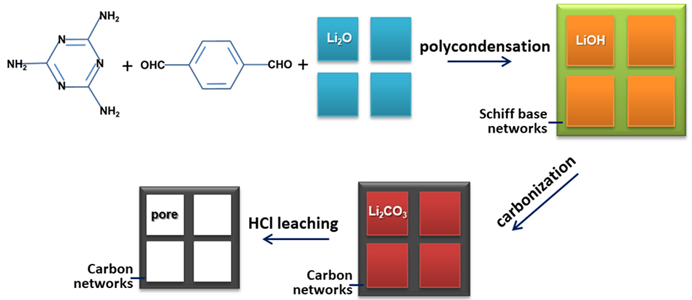D.-C Guo, C.-S. Sun, W. Wu, Z.-S. Wu, J. Gao, N. Su, J. Chen
Applied Surface Science, 2019, 493, 177-184.
DOI: 10.1016/j.apsusc.2019.06.200 [PDF]

The fabrication of nanocarbons possessing ultrathin graphitic structure and ultrahigh nitrogen doping simultaneously remains challenging so far. Herein, we develop a novel and versatile strategy to prepare ultrahigh nitrogen-doped hierarchical porous carbon with ultrathin graphitic framework (NHPCs), through the Schiff-base reaction of melamine and terephthalaldehyde in the presence of lithium oxide, as high-performance anodes for rechargeable lithium ion batteries. During one-pot solid-phase interface reaction, Li2O was used to absorb the in-situ generating H2O enhancing the formation of Schiff-based networks and LiOH was in-situ obtained, which can be used as active agent to increase the BET surface areas of final carbons. The obtained NHPCs present 3D hierarchical honeycomb-like morphology, ultrahigh nitrogen content up to 12.2 wt%, large specific surface area of 1260 m2 g−1. These unique structural properties allowed for fast ion diffusion and rapid electron transport, and offered enriched active sites for lithium storage. NHPCs presented a high reversible capacity of 880 mAh g−1 at 100 mA g−1 even after 100 cycles, and exceptional rate capability with 301 mAh g−1 at 3000 mA g−1, outperforming most reported nano‑carbons. Therefore, this strategy will open a new way to prepare heteroatom-doped porous carbons with a controllable hierarchical structure, for high-performance energy storage.
|